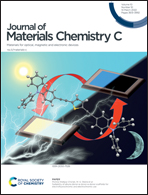Controlling screw dislocation evolution towards highly homogeneous quasi-two-dimensional (BA)2(MA)n−1PbnI3n+1 single crystals for high-response photo-detectors†
Abstract
Recently, quasi-two-dimensional (quasi-2D) organic–inorganic hybrid perovskites, such as those obtained by introducing long-chain organic cations like n-butylammonium (BA) into 3D MAPbI3 perovskites, have been widely investigated as optoelectronic devices owing to their high light absorption coefficient, ultra-long carrier diffusion length, and high defect tolerance. Controlling the BA content to obtain (BA)2(MA)n−1PbnI3n+1 with homogeneous n values is crucial for extraction of photo-carriers because volatile n value related interior heterojunctions are unfavorable for extraction of photo-carriers. Here, we revealed the fundamental growth mechanism of (BA)2(MA)n−1PbnI3n+1. The growth mechanism of (BA)2(MA)n-1PbnI3n+1 SCs is controlled by the evolution of macroscopic spiro dislocations and its derived growth steps. In terms of the understanding of the surface growth mechanism, we grew a series of single crystals with individual n values, avoiding interior heterojunctions, and obtained a lower dark current of 0.247 nA, a high photocurrent (74.5 nA) and high responsiveness (0.064 A W−1) and an external quantum efficiency of 19.5% for a photodetector based on the (BA)2(MA)3Pb4I13 SC. This contributes to an in-depth understanding of the growth mechanism of quasi-2D (BA)2(MA)n−1PbnI3n+1 SCs and the development and optimization of quasi-2D layered materials and devices for optoelectronics.



 Please wait while we load your content...
Please wait while we load your content...